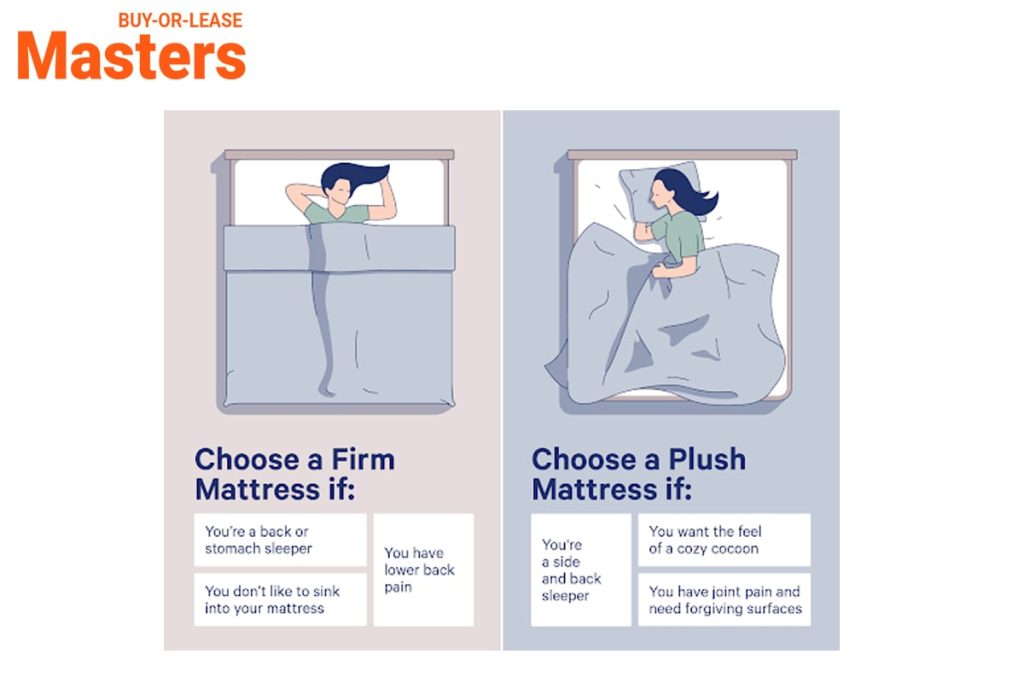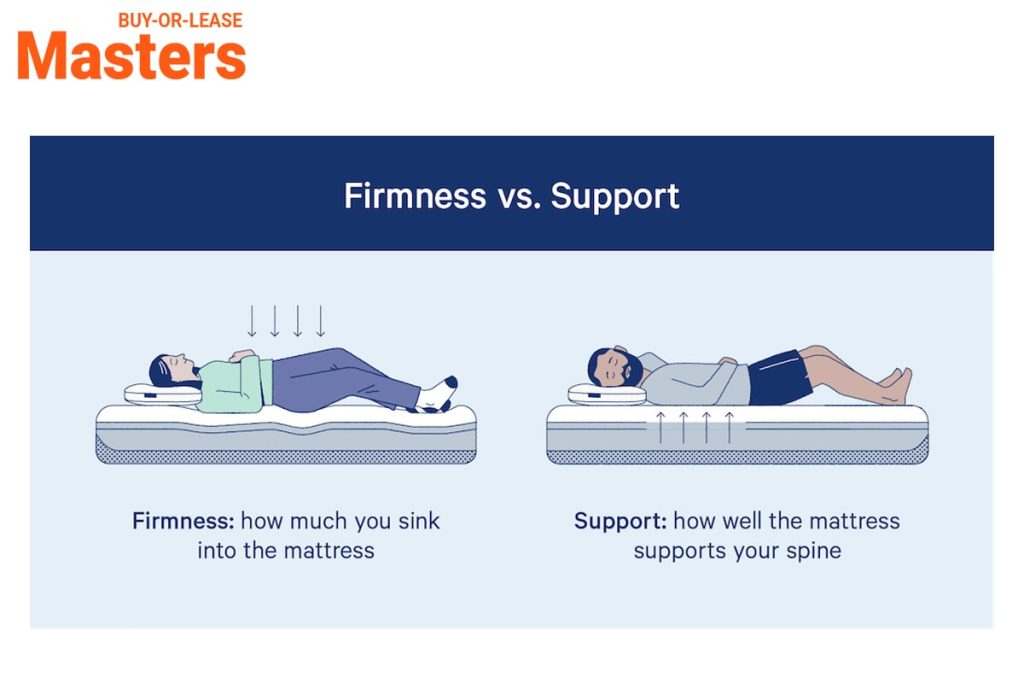Do you ever have difficulty sleeping at night because your mattress isn’t provide enough support or it’s uncomfortable? If so, you certainly aren’t alone. The debate between whether a mattress should be firm or soft is an age old one that has perplexed sleepers for centuries. From the advances in technology to long standing tradition of construction methods, there are multiple factors to consider when making the decision over which mattress best suits your needs and preferences. Today, Mastersbuyorlease will explore the pros and cons of both firm and soft mattresses helping you make an informed decision about which one might be better suited for optimal sleep health.
Sleeper Considerations

One of the most important factors in determining whether to invest in a firm or soft mattress is personal preferences. We are showing some key considerations to help you make the decision:
Comfort preferences
For those who prefer a soft, plush feel, a softer mattress may be the way to go. However, for individuals who need extra support or suffer from back pain, a firmer mattress might be more beneficial. It is important to take into account your own comfort preferences when deciding which type of mattress to choose.
Body weight
Your body weight plays a significant role in determining how firm or soft your mattress should be. Generally, heavier individuals may prefer a firmer mattress for more support, while lighter individuals may want a softer mattress for comfort.
Sleep position
Another important consideration is your sleep position. For those who sleep on their back or stomach, a firmer mattress may provide better support and alignment. On the other hand, side-sleepers may prefer a softer mattress to alleviate pressure points on their hips and shoulders.
Partner preferences
If you share your bed with a partner, it is important to also take their preferences into account. You may have to compromise and find a balance between firmness levels that works for both of you.
For example: When co-sleeping with your children, nieces or nephews, or pets, it is important to take into account their preferences, weight, sleep position, and other factors, as well as your own. It may be necessary to find a mattress that accommodates everyone’s needs for a good night’s sleep.
How is Firmness Measured?
The firmness of a given mattress is commonly assessed using a scale ranging from 1 to 10.
- 1/10 – extremely soft, the body will sink in deeply. This level of softness provides a luxurious and enveloping feeling, like sleeping on a cloud. It is uncommon to find mattresses that are made this soft, making it a rare and indulgent choice for those who prefer maximum plushness.
- 2-3/10 – soft, the body will sink in significantly. This level of softness is ideal for side sleepers weighing under 130 pounds, as it provides ample support while allowing for proper spinal alignment. It offers a gentle cradling sensation, relieving pressure points and promoting a restful sleep.
- 4/10 – medium soft, a plush surface with good conforming and less sinkage. This level of softness strikes a balance between comfort and support. It offers a gentle contouring effect, hugging the body’s curves without excessive sinking. It is a popular choice for those who enjoy a softer sleeping surface without sacrificing support.
- 5/10 – medium, a balance of conforming and firmness, with little sinkage. This level of firmness is considered versatile, appealing to a wide range of sleepers. It provides a comfortable blend of contouring and support, accommodating different sleeping positions and body types. It strikes a balance between cushioning and firmness, offering a pleasant sleeping experience.
- 6/10 – medium firm, less conforming and a somewhat firmer feel. This level of firmness offers a slightly firmer sleeping surface, providing a touch more support and less contouring. It is suitable for sleepers who prefer a bit more resistance and a firmer feel while still maintaining some level of cushioning.
- 7-8/10 – firm, no sinkage, minimal conforming. This level of firmness offers a sturdy and supportive sleeping surface. It is typically preferred by sleepers weighing over 230 pounds, as it provides excellent spinal alignment and prevents excessive sinking. It offers minimal contouring, ensuring a stable and supportive sleep environment.
- 9-10/10 – extra firm, a very hard surface with no conforming. This level of firmness provides an extremely firm and unyielding sleeping surface. It offers little to no give, providing a solid and supportive foundation. It is a rare choice, suitable for sleepers who prefer an exceptionally firm feel.
Firm vs Soft Mattresses

So, which is the better option? It ultimately depends on your personal preferences and individual needs. To help you make an informed decision, let’s take a quick look at the pros and cons of firm vs soft mattresses.
Soft Mattresses
Pros of Soft Mattresses
- Offers a comfortable and plush sleeping surface.
- Provides pressure relief for those with joint pain or pressure points.
- Ideal for side sleepers and lighter individuals.
- Great for co-sleeping with children or pets.
Cons of Soft Mattresses
- May not provide enough support for those with back pain or heavier body weight.
- Can cause excessive sinking, leading to poor spinal alignment.
- May be difficult for some individuals to get in and out of.
Firm
Pros of Firm Mattresses
- Offers excellent support and can help alleviate back pain.
- Promotes proper spinal alignment by preventing excessive sinking.
- Suitable for heavier individuals and those who prefer a firmer feel.
- Can handle more weight, making it a better long-term investment.
Cons of Firm Mattresses
- May not be comfortable or provide enough cushioning for side sleepers or lighter individuals.
- Can cause discomfort for those with sharp pressure points.
- May take some getting used to for those accustomed to softer sleeping surfaces.
Considerations when Choosing Between the Two
When deciding between a firm or soft mattress, it is crucial to consider your body weight, sleep position, and any potential partner preferences. It may also be helpful to try out different mattresses in-store or take advantage of free trials offered by some brands.
Remember that finding the perfect mattress for you is a personal journey. What works for someone else may not work for you, so take the time to find a mattress that meets your unique needs and preferences. Ultimately, the key is to prioritize comfort and support for a restful and rejuvenating sleep experience. So, should the mattress be firm or soft? The answer is whichever provides the best night’s sleep for you.
Traditional Construction Methods for a Firm or Soft Mattress
Mattresses can be constructed in various ways to achieve different levels of firmness. Here are some traditional construction methods commonly used for firm or soft mattresses:
- Pocketed Coils: These individually wrapped coils contour to the body and provide targeted support while reducing motion transfer. They can be used for both firm and soft mattresses, depending on the additional layers and materials used.
For example, a firm mattress may use more layers of foam or latex on top of the pocketed coils for added support, while a soft mattress may have fewer layers for a softer feel.
- Innerspring Coils: These interconnected coils offer solid support and are commonly used in firm mattresses. They provide a traditional bouncy feel and can be combined with additional layers for added comfort.
- Memory Foam: This material is known for its ability to conform and contour to the body’s shape, making it popular for softer mattresses. It can also be used in firm mattresses as a top layer for added cushioning and pressure relief.
- Latex Foam: Natural latex foam is inherently supportive but can also provide a plush sleeping surface. It is commonly used in medium or firm mattresses, offering a balance between support and comfort.
- Hybrid Construction: A combination of different materials can be used to create hybrid mattresses that offer a blend of firmness levels. For example, a mattress could have a pocketed coil base with memory foam or latex layers on top for both support and conforming properties.
What is the Best Choice for You – Firm or Soft?
As mentioned earlier, the best choice ultimately depends on your individual preferences and needs. Both firm and soft mattresses can offer a comfortable and supportive sleep experience, as long as they are suited to your specific requirements.
If you have back pain or are heavier in weight, a firmer mattress may be more beneficial for proper support and spinal alignment. On the other hand, if you are a side sleeper or prefer a plush sleeping surface, a softer mattress may be ideal for pressure relief and comfort.
It’s important to remember that the firmness of a mattress can also affect its durability. A firmer mattress may last longer and retain its shape better, while a softer mattress may develop indentations over time. Consider your budget and how often you plan on replacing your mattress when deciding between firm or soft.
In conclusion, there is no right or wrong answer to whether a mattress should be firm or soft. It all comes down to personal preference and finding the right balance of support and comfort for a good night’s rest. So take the time to research and try out different options to find the perfect mattress for you.
Conclusion.
Choosing the right mattress is a personal decision and should take into account your own comfort preferences, body weight, and sleeping position. Those who tend to sleep on their back or stomach might benefit the most from a firmer mattress due to its added support. While those who prefer more cushioning while they rest may prefer a softer mattress design. It’ s important to consider all these factors when making your decision as this can be integral in providing you with the best sleep possible. Whatever you decide, or whatever advice we can provide, nothing beats taking the time to test out beds of all types in order to find what works best for you. So don’ t shy away from trying multiple mattresses before you make a choice. It could be the difference between finding the right mattress that helps you get quality rest night after night or not. If you have any further questions or opinions about this topic, feel free to leave a comment below and start the conversation.


Leave a Reply